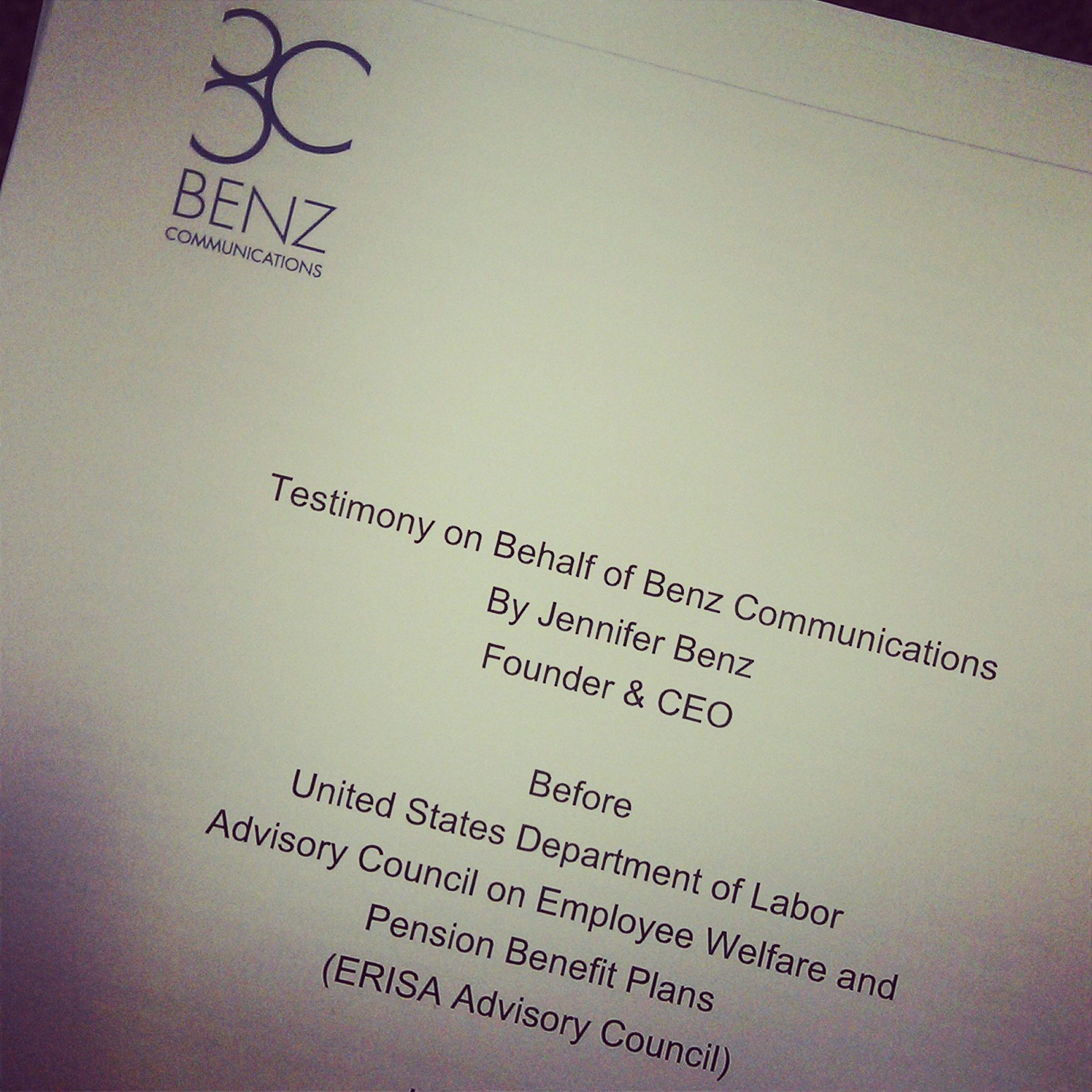
Benz Communications goes to Washington
Informative, spirited and engrossing—probably not the first three words that come to your mind when you envision the inner workings of the Department of Labor. That’s okay; we don’t blame you. 
Still, when I accompanied Jen earlier this month as she channeled Jimmy Stewart in “Mr. Smith Goes to Washington,” I assure you, all of the aforementioned adjectives apply.
Speaking before the DOL’s ERISA Advisory Council in the nation’s capital, Jen—in addition to representatives from Aon Hewitt, Callan Associates, the American Benefits Council, Lincoln Financial and TIAA-CREF—spoke with passion, commitment and authority about how the government could best assist you in developing and implementing effective retirement communication.
“There are two conflicting realities that come into play when we consider saving for and communicating about retirement through the workplace: The first is that for many employees, retirement is more than 50 years into the future,” Jen reminded the Council. “The second is that statistics tell us that most Americans will only stay with their current employer about one-tenth of that time, an average of 5.2 years.”
She also shared with the Council exactly what you told us in last year’s Inside Benefits Communication Survey about the challenges you face when it comes to setting goals and obtaining sufficient budgets for benefits communication.
But Jen didn’t stop there. She continued: “When it comes to the sophisticated communications and marketing required to change people’s financial behaviors, employers are working against two powerful forces: a financial services industry that takes advantage of individuals by making debt seem inconsequential … and a consumer-spending machine that makes buying more desirable than saving. This is not a battle that can be waged without major resources, but that’s what most employers are up against.”
Great stuff, right? We know—preaching to the choir. To read Jen’s full testimony, download the PDF here.
Even better, though, is that all of Jen’s fellow witnesses echoed her sentiments—that your jobs are tough and are only made tougher by societal pressures and lack of resources.
The council members posed questions to each witness following the witness’s prepared remarks. The Q&A sessions were by far the most interesting part of the day, as I saw how informed and interested the Council is in making this aspect of your job easier by greasing the wheels of change.
As the group that will ultimately make recommendations to DOL on if/how to issue new guidance on retirement communication, you’ll be happy to know that these folks know their stuff. Like Margaret Mead once said, “Never doubt that a small group of committed people can change the world.”
During Jen’s Q&A, the council members peppered her with questions:
How can employers better connect the messages of health care and retirement?
“CDHPs are moving forward for employers, so they can talk about HSAs as a vehicle for long-term savings. They can communicate to employees, ‘If you’re not spending extra money on health care premiums, you can put that savings into your 401(k) or purchase long-term care coverage, etc.’”
For the DOL to give the “green light” to using social media in retirement communication, what would have to change?
“Social media can’t and shouldn’t replace baseline communications, but employers can embed social media—twitter, YouTube—onto websites outside the firewall. But right now, employers are still too shy about using social media because of fear of employee comments or sharing too much information about their plans. There are ways to implement social media that carry no more risk than publishing a web page, but because one area is challenging, too many employers have decided to do nothing. They need to be given permission to use these tools, and the DOL can help with that.”
What lessons can we learn from behavioral economics?
“Employers that implement lessons of behavioral economics in their communications will get better results than the employer that lets their attorneys drive communications.”
Are the required legal disclosures really not useful to plan participants in printed form?
“People just don’t understand them. It’s not the type of communication that’s going to encourage people to save more; it’s not action-oriented. I think putting fee disclosure information online with an interactive tool that says, ‘Here’s how to get into funds with lower fees. Here’s what this information means to you, and here’s the action you can take’ would be much more effective. But the baseline is print and employers have limited resources. So, the ‘here’s what it means to you; here’s the action’ part is what gets missed.”
Are written communications better than a one-on-one format?
“I don’t know anyone who wouldn’t prefer someone to sit down and explain all of this information to them. But for most employers, that’s not a realistic expense.”
And although we didn’t get to charge the Capitol steps, and there was no climactic coda like Jimmy Stewart’s in the movie, we ended the day feeling hopeful and energized to keep doing our part on behalf of you and your employees. As Jen said, “We have the opportunity to really change the dialog for our country and help more Americans live happy, successful, financially secure lives.”
To learn more about the ERISA Advisory Council, click here.
